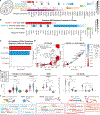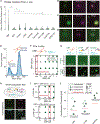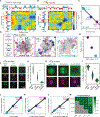Macromolecular condensation organizes nucleolar sub-phases to set up a pH gradient
- PMID: 38503281
- PMCID: PMC11938373
- DOI: 10.1016/j.cell.2024.02.029
Macromolecular condensation organizes nucleolar sub-phases to set up a pH gradient
Abstract
Nucleoli are multicomponent condensates defined by coexisting sub-phases. We identified distinct intrinsically disordered regions (IDRs), including acidic (D/E) tracts and K-blocks interspersed by E-rich regions, as defining features of nucleolar proteins. We show that the localization preferences of nucleolar proteins are determined by their IDRs and the types of RNA or DNA binding domains they encompass. In vitro reconstitutions and studies in cells showed how condensation, which combines binding and complex coacervation of nucleolar components, contributes to nucleolar organization. D/E tracts of nucleolar proteins contribute to lowering the pH of co-condensates formed with nucleolar RNAs in vitro. In cells, this sets up a pH gradient between nucleoli and the nucleoplasm. By contrast, juxta-nucleolar bodies, which have different macromolecular compositions, featuring protein IDRs with very different charge profiles, have pH values that are equivalent to or higher than the nucleoplasm. Our findings show that distinct compositional specificities generate distinct physicochemical properties for condensates.
Keywords: Cajal bodies; biomolecular condensates; condensation; emergent property; evolution; interphase; nuclear speckles; nucleolus; pH; phase separation; proton motive force; reconstitution.
Copyright © 2024 The Author(s). Published by Elsevier Inc. All rights reserved.
Conflict of interest statement
Declaration of interests R.V.P. is a member of the scientific advisory board for and shareholder in Dewpoint Therapeutics Inc.
Figures







References
-
- Shaw PJ, and Jordan EG. (1995). The Nucleolus. Annu. Rev. Cell Dev. Biol. 11, 93–121. - PubMed
-
- Shan L, Xu G, Yao R-W, Luan P-F, Huang Y, Zhang P-H, Pan Y-H, Zhang L, Gao X, Li Y, et al. (2023). Nucleolar URB1 ensures 3′ ETS rRNA removal to prevent exosome surveillance. Nature 615, 526–534. - PubMed
-
- Boisvert FM, van Koningsbruggen S, Navascués J, and Lamond AI. (2007). The multifunctional nucleolus. Nat. Rev. Mol. Cell Biol. 8, 574–585. - PubMed
-
- Kraushar ML, Krupp F, Harnett D, Turko P, Ambrozkiewicz MC, Sprink T, Imami K, Günnigmann M, Zinnall U, Vieira-Vieira CH, et al. (2021). Protein Synthesis in the Developing Neocortex at Near-Atomic Resolution Reveals Ebp1-Mediated Neuronal Proteostasis at the 60S Tunnel Exit. Mol. Cell 81, 304–322.e16. - PMC - PubMed
MeSH terms
Substances
Grants and funding
LinkOut - more resources
Full Text Sources
Other Literature Sources

